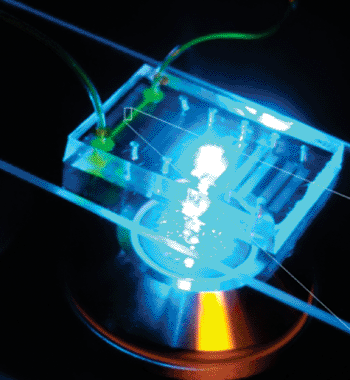Blood Test Can Rapidly Detect Infection Risk
By LabMedica International staff writers
Posted on 11 Dec 2013
A device has been created that is able to detect a person's risk of infection from a drop of blood within minutes, as opposed to current methods, which can take up to two hours. Posted on 11 Dec 2013
Neutrophil chemotaxis is critical for defense against infections and its alterations could lead to chronic inflammation and tissue injury and the central role that transient alterations of neutrophil chemotaxis could have on patient outcomes calls for its quantification in the laboratory.

Image: Microfluidic device for six assays under the microscope (Photo courtesy of BioMEMS Resource Center).
Scientists at the Massachusetts General Hospital (Boston, MA, USA) designed a microfluidic device to study neutrophil chemotaxis from a single droplet of whole blood, which has three main components: a chemokine side chambers (200 × 200 μm), a central whole-blood loading chamber, and migration channels containing red blood cell (RBC) filtering regions.
The filter for each migration channel consists of 10 short channels (length about 75 μm) connected horizontally through an approximately 200-μm-long channel to create 90 degree bending sections capable of trapping the RBCs in order to prevent them from dispersing into the rest of the migration channel. A gradient of the chemoattractant is established along the migration channels by diffusion between the chemoattractant chambers and the central loading chamber.
The assay was validated by comparing neutrophil chemotaxis from finger prick, venous blood and purified neutrophil samples. There was a consistent average velocity of 19 ± 6 μm/minute and directionality of 91.1% between the three sources. The team quantified the variability in neutrophil chemotaxis between healthy donors and found no significant changes over time. The novel whole blood device was also used to monitor neutrophil chemotaxis function in a patient with 24% total body surface area burns over a three-week treatment period.
Daniel Irmia, MD, PhD, an assistant professor at the BioMicro Electrical Mechanical Systems Resource Center (BioMEMS; Boston, MA, USA) and a senior author of the study said, “In many cases, it may not be enough to just count the neutrophils. If neutrophils do not migrate well and cannot reach inside the tissues, this situation could have the same consequences as a low neutrophil count.” The authors concluded that being able to measure patients' risk of infections in a matter of minutes from only a droplet of blood is a significant development and one that will improve current treatment. The study was published on October 2, 2013, in the journal Technology.
Related Links:
Massachusetts General Hospital
BioMEMS Resource Center







 Analyzer.jpg)

 assay.jpg)




